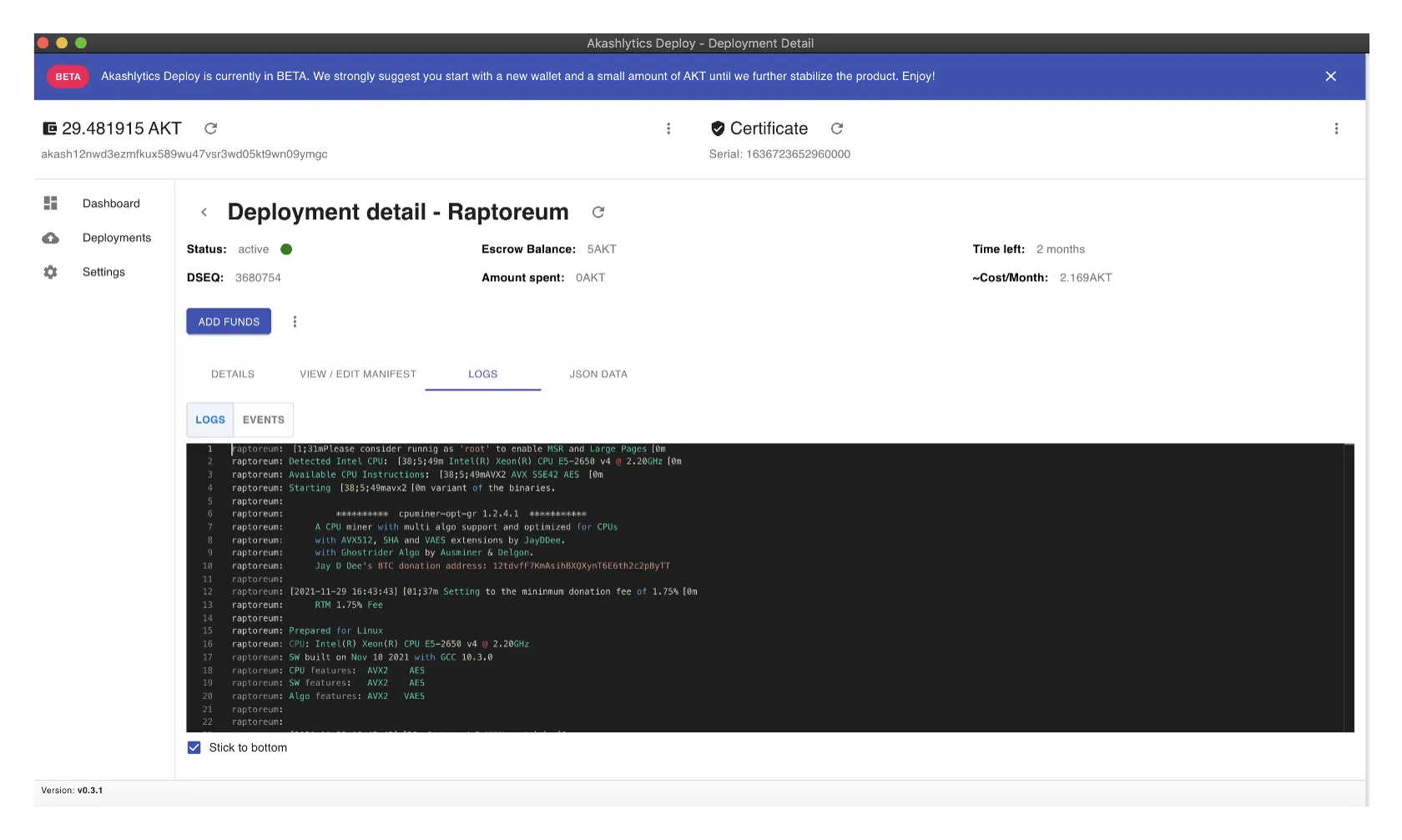
Why use Akash?
Welcome Raptoreum **** miners! Akash is a decentralized marketplace of compute with thousands of CPU’s ready for small and large deployments. Raptoreum mining can be deployed on the network successfully using this guide. Akash is a part of the Cosmos ecosystem of blockchains.
Windows/Linux/Mac Users
- Install Keplr **** wallet as a browser plugin
- Go to the Akash Console **** and import your AKT wallet address from Keplr
- Fund your wallet
For additional help we recommend you follow our full deployment guide **** in parallel with this guide.
How does this work?
Akash uses its blockchain to manage your container deployment and accounting. To deploy on Akash you will need to fund your wallet with at least 10 AKT. Each time you create a deployment, 0.5 AKT will be used for escrow and to fund the deployment. If the deployment is cancelled, the balance of the escrow is returned to you. You can spin up deployments without worrying about any long term contracts and you can cancel anytime.
Default wallet
Akash uses Keplr as the desktop wallet. Advanced users can follow the **** CLI wallet instructions.
Quickest way to get more AKT
To fund your deployment you will need AKT in your account. The fastest way to do that is in one of the following two ways.
Buy on an Exchange
Swap from ATOM to AKT
- Install **** Keplr.
- Send 10 ATOM to your new Cosmos wallet address inside Keplr (this address will start with cosmos).
- Go to **** Osmosis Assets > next to Cosmos Hub - ATOM click on Deposit. This step will deposit ATOM from your Keplr wallet onto the Osmosis platform. Press Connect Wallet to connect your Keplr wallet to Osmosis.
- Now go back to **** Osmosis Homepage **** and ensure ATOM > AKT is selected to complete the swap. This step swaps your ATOM you deposited onto the Osmosis platform into any other supported coin.
- Return to the **** Osmosis Assets page to withdraw your AKT to your Keplr wallet. This step withdraws AKT from the Osmosis platform back into your Keplr wallet. You can now send AKT to Akash Console
Have more questions? Find our team in **** Discord and Telegram.
Deploying on Akash
Once you have set up your Keplr wallet and imported the address to Akash Console you are ready to create your first deployment. Follow the instructions in Akash Console to create a certificate, then click on Create Deployment.
When prompted to Choose Template select Empty as we will copy-and-paste the deploy.yaml file from this repository (listed below). Choose Empty for the template and paste the deploy.yaml file adjusting your wallet address and pool variables as desired.
---version: "2.0"
services: raptoreum: image: cryptoandcoffee/cpu-akash-cpuminer-gr-avx2:2 expose: - port: 4048 as: 80 proto: tcp to: - global: true env: - "ADDRESS=RMB251ZucvCNyX1yoQqsSC2wwJ3s7fHx3b" - "POOL=suprnova" #You can enter custom pool here, otherwise suprnova nearest location will be used - "WORKER=akash" - "TUNE=no-tune" - "DONATION=0"profiles: compute: raptoreum: resources: cpu: units: 1.0 memory: size: 256Mi storage: size: 128Mi placement: akash: pricing: raptoreum: denom: uakt amount: 2
deployment: raptoreum: akash: profile: raptoreum count: 1Choosing a provider
Akash is a marketplace of compute. Providers set their own prices for compute resources. We recommend you try different providers and check your logs after deployment to determine the hashrate.
.Cjz_HlIe_25kIKp.webp)
How to speed up mining?
Change the tuning option
TUNE=no-tune variable in deploy.yaml to TUNE=full-tune
No tune will start mining right away - with no performance tuning of the container. Without this expect a lower hashrate. Be warned, tuning can take at least 3 hours before mining begins - so do not expect to see hashrate on the pool immediately. You can check your logs in Akash Console.
Increase the deployment size on Akash
You can deploy more CPUs to mine faster.
cpu: units: 1.0 # Max cpu units is 10Or increase the replica count from count: 1 to count: 2.
deployment: raptoreum: akash: profile: raptoreum count: 1 # Multiplier for cpu:unitsCheck your profitability
After your deployment has finished tuning or is displaying results on the pool you can check your profitability by inputting your hashrate from the log file.
Minerstat profitability calculator
What is the best pool? Where do I solo mine?
We recommend you check MiningPoolStats for the most up-to-date list of mining pools.